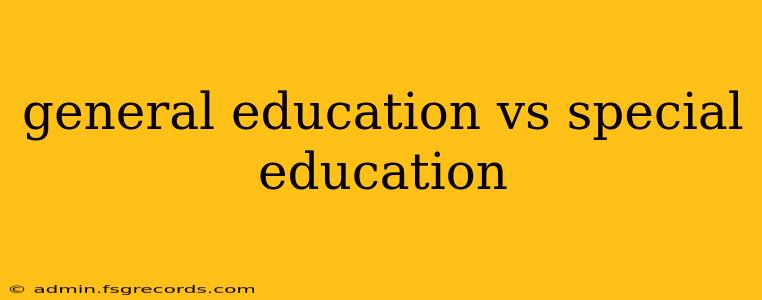Choosing the right educational path for a child is a crucial decision for parents and guardians. This often involves understanding the key distinctions between general education and special education. While both aim to provide a quality learning experience, they differ significantly in their approaches, methodologies, and the needs they address. This comprehensive guide will delve into the core differences, highlighting the similarities and emphasizing the importance of individualized education plans (IEPs) and 504 plans.
What is General Education?
General education refers to the standard educational program offered to all students in a school setting. It follows a predetermined curriculum designed to meet the needs of the average learner. This curriculum covers a broad range of subjects, including mathematics, language arts, science, social studies, and often incorporates physical education, arts, and music. The teaching methods are typically geared towards a classroom of diverse learners, utilizing various strategies to cater to different learning styles. However, the pace and content are generally standardized.
Key Characteristics of General Education:
- Standardized Curriculum: Follows a pre-defined curriculum for all students within a grade level.
- Diverse Classroom: Includes students with a wide range of abilities and learning styles.
- One-Size-Fits-Most Approach: Teaching methods are generally designed for the average learner.
- Focus on Grade-Level Standards: Aims to meet state or national educational standards for each grade.
What is Special Education?
Special education is designed to provide individualized instruction and support for students with disabilities. These disabilities can range from learning disabilities (like dyslexia or ADHD) to physical, emotional, or intellectual impairments. Special education aims to help students overcome their challenges and achieve their full potential. It's characterized by individualized education programs (IEPs) that outline specific learning goals, accommodations, and modifications tailored to each student's unique needs.
Key Characteristics of Special Education:
- Individualized Education Program (IEP): A legally binding document outlining specific goals, services, and accommodations for each student.
- Specialized Instruction: Teaching methods are adapted to meet the individual student's learning style and needs.
- Specialized Support Services: May include speech therapy, occupational therapy, physical therapy, counseling, and other support services.
- Modified Curriculum: The curriculum may be modified or adapted to meet the student's individual needs and abilities.
- Inclusion vs. Separate Settings: Students may be included in general education classrooms with support, or they may receive instruction in a separate special education classroom or setting, depending on their needs and the IEP.
504 Plans: A Bridge Between General and Special Education
A 504 plan is a plan developed under Section 504 of the Rehabilitation Act of 1973. It's designed to provide accommodations for students with disabilities that significantly impact their ability to access general education. Unlike an IEP, a 504 plan doesn't require specialized instruction but offers accommodations within the general education setting.
Key Differences Between 504 Plans and IEPs:
- Eligibility: IEPs are for students with disabilities requiring specialized instruction, while 504 plans are for students with disabilities affecting their ability to access education.
- Services: IEPs provide specialized instruction and support services, while 504 plans provide accommodations within the general education setting.
- Legal Framework: IEPs are governed by the Individuals with Disabilities Education Act (IDEA), while 504 plans are governed by Section 504 of the Rehabilitation Act.
Similarities Between General and Special Education:
Despite their differences, both general and special education share a common goal: to provide students with the best possible learning environment to foster academic success and personal growth. Both aim to create supportive, inclusive, and stimulating learning environments where students can reach their full potential. Effective collaboration between general and special education teachers is crucial in creating a seamless and successful learning experience for all students.
Conclusion: A Collaborative Approach
Ultimately, the most effective educational approach often involves a collaborative effort between general and special education teachers. By understanding the strengths and weaknesses of each approach, and effectively implementing IEPs and 504 plans, schools can create learning environments that effectively cater to the diverse needs of all students. The key is to focus on the individual needs of the child and develop a personalized plan that allows them to thrive. This collaborative approach ensures every child receives the support and education they deserve, regardless of their abilities or challenges.

